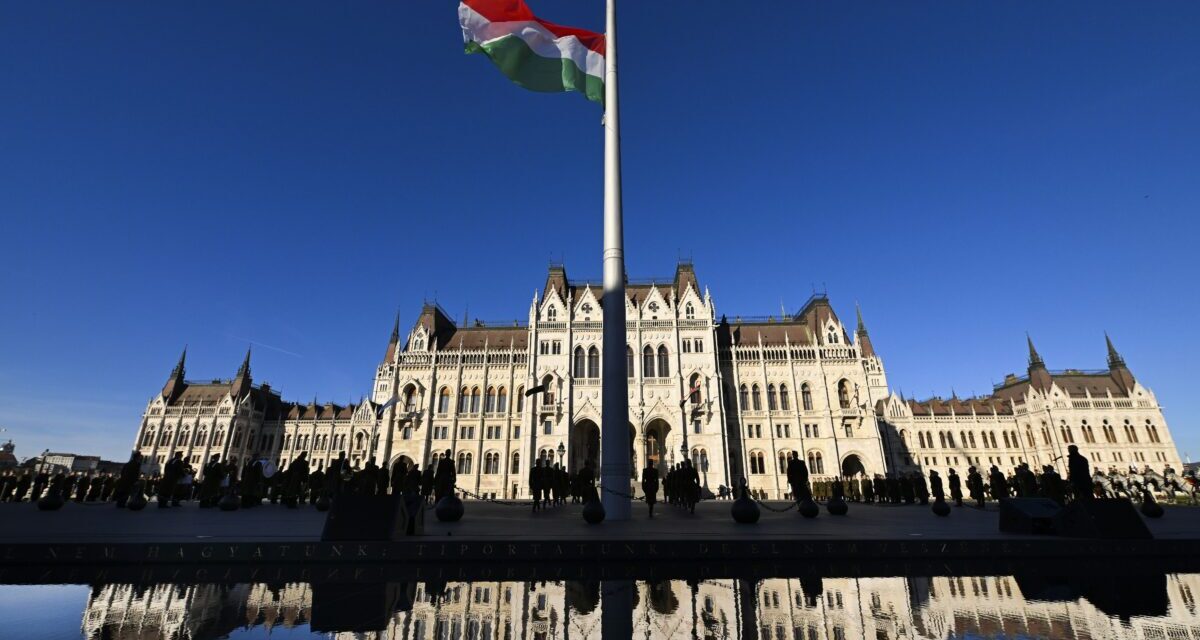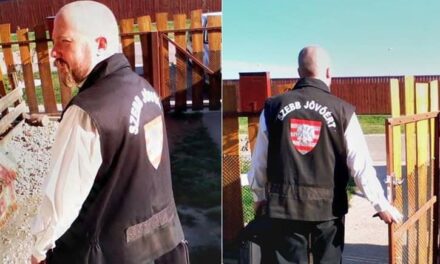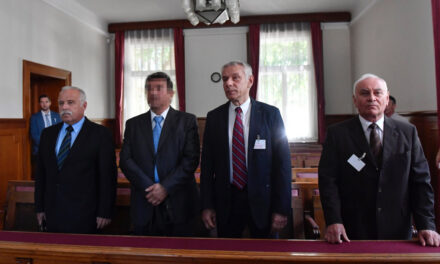The day the revolution was crushed is now a national day of mourning.
In addition to a military tribute, in the presence of Minister of National Defense Kristóf Szalay-Bobrovniczky, Lt. Gen. Ferenc Kajári, Deputy Chief of the General Staff of the Armed Forces, and Colonel József Mudra, Brigade Commander of the Budapest Garrison, the national flag was ceremoniously raised and then lowered to half-mast on the National Day of Mourning, the 1956 Revolution and War of Independence on the anniversary of the defeat and the entry of the Soviet troops on Monday at Kossuth Lajos Square in front of the Parliament.
As an expression of mercy, Hungary's flag will remain at half-mast all day on the national day of mourning.
The national flag was raised to half-mast by the National Anthem and lowered to half-mast by the soldiers of the 32nd Bodyguard Regiment of the Sándor Budapest Garrison Brigade of the Hungarian Armed Forces Vitéz Szurmai. The central band of the Hungarian Armed Forces, the hussar division of Count Nádasdy Ferenc and the national cavalry honor unit took part in the ceremony.
On the National Day of Mourning, a memorial concert will be organized in the Basilica of St. István in Budapest, which will be broadcast live by Bartók radio from 6:00 p.m., and recorded by the M5 cultural channel from 10:42 p.m. After the memorial concert, there will be a joint candle lighting on the main staircase of the Basilica.
Let's remember the heroes who gave their lives for our freedom! - wrote Prime Minister Viktor Orbán in his Facebook post on Monday, who paid tribute to the memory of the heroes on the national day of mourning, the day of the defeat of the 1956 revolution and freedom struggle.
Zoltán Kovács, the state secretary responsible for international communication, also commemorated the day of national mourning: Gloria victis! - he wrote in his post, praising the glory of heroes:
On November 4, we remember the victims of the 1956 revolution and war of independence, the anniversary of the entry of Soviet troops. The compilation of the Press Archive of the National Archives reminds us: on October 23, 1956, a revolution started with a peaceful demonstration and continued with an armed uprising against the communist dictatorship associated with the name of Mátyás Rákosi and the Soviet occupation.
After the intervention of the Soviet troops in Hungary, the revolution turned into an armed struggle for freedom. Its fate was sealed by the Soviet military invasion on November 4, four days after the Hungarian government led by Imre Nagy declared the country's neutrality and terminated the Warsaw Pact. The intervention was already decided in Moscow on October 31, and from then on, Soviet troops continuously arrived in Hungary.
On Sunday, November 4, 1956, at four o'clock in the morning, the Soviet army launched a general attack against Budapest, the larger cities and the most important military installations. The defenders of the capital - national guards, police and smaller and larger army units - took up the fight. During the day, the Soviet troops disarmed all units of the Hungarian People's Army. The Soviet troops occupied the Ministry of National Defense, the Ministry of the Interior and the Budapest Police Headquarters until noon. In the countryside, significant resistance developed in several places.
At 5:05 a.m., in a statement broadcast by Ungvár radio, Antal Apró, János Kádár, István Kossa and Ferenc Münnich, the former ministers of the Imre Nagy government, who left for the Soviet Union on November 1st, announced that they had severed all ties with the Imre Nagy government, at the same time initiated the formation of the Hungarian Revolutionary Workers' and Peasants' Government under the leadership of János Kádár. That day, Kádár and Münnich flew to Szolnok with a Soviet escort.
At 5:20 p.m., Imre Nagy's short, dramatic radio speech was delivered, which was repeated several times and read in all world languages:
"Imre Nagy, President of the Council of Ministers of the Hungarian People's Republic, is speaking here. Early today, Soviet troops launched an attack on our capital, with the obvious intention of overthrowing the legitimate Hungarian democratic government. Our teams are in battle. The government is in place. I announce this to the people of the country and to the public opinion of the world".
The broadcast of Szabad Kossuth Radio was interrupted at 8:07 a.m., after which the Anthem and the Sermon were broadcast alternately on shortwave.
After the Yugoslav Ambassador Dalibor Soldatic informed State Minister Zoltán Szántó in the early hours of the morning that the Yugoslav government would provide asylum to Imre Nagy and his companions, Imre Nagy, Ferenc Donáth, Géza Losonczy, György Lukács and Zoltán Szántó arrived at the Yugoslav embassy between 6 and 8 a.m.; Cardinal József Mindszenty was granted asylum at the American embassy.
At the Yugoslav embassy, 43 people were granted asylum, with whom Soldatic explained the message of Yugoslav President Tito to recognize the Kádár government, which Imre Nagy and his colleagues unanimously rejected.
István Bibó, the only representative of the legitimate Hungarian government left in the Parliament building, issued a manifesto. In it, he announced that Hungary had no intention of pursuing an anti-Soviet policy, and rejected the accusation that the revolution was fascist or anti-communist in nature. He called on the Hungarian people not to recognize the invading Soviet army or the puppet government that might be set up, and to use all the weapons of passive resistance against it.
US President Dwight D. Eisenhower protested the Soviet intervention. At the meeting of the Security Council, the Soviet Union vetoed the proposed American resolution calling for the withdrawal of Soviet troops. In the afternoon, the extraordinary general assembly accepted the extended American proposal, which also asked the UN Secretary General to appoint a committee to examine the situation in Hungary.
In a telegram, the Kádár government asked the UN Secretary General to remove "the Hungarian question" from the agenda.
The fighting in the capital on November 4 claimed 135 lives. According to the KSH's January 1957 report, the events between October 23 and January 16 claimed 2,652 lives nationwide (2,045 in Budapest) and injured 19,226 (16,700 in Budapest). According to an official statistic compiled in 1991, 669 soldiers of the Soviet Army lost their lives in the fighting, 51 were missing. The leaders of the revolution: Prime Minister Imre Nagy, Minister of National Defense Pál Maléter, journalist Miklós Gimes were executed on June 16, 1958 after a trial. The case of József Szilágyi - Imre Nagy's personal secretary - was separated, and he was executed in April 1958. Minister of State Géza Losonczy died in prison under circumstances that are still unclear.
During the reprisal, the number of people executed for participating in the revolution (according to different sources) was 220-340, thousands were sentenced to prison terms and internment.
In 2013, the government officially declared November 4 a national day of mourning. In the case of national mourning, the Hungarian flag is raised in front of the Parliament in a ceremonial setting, with military honors, and then lowered to half-mast. In the case of flag use, a mourning flag must be displayed on public buildings defined by law, and in case of flag use, the Hungarian flag and the European flag must be flown at half-mast. In schools, a worthy commemoration must be held during class or at a separate student event. In public entertainment venues, music and broadcast services may be restricted - in accordance with the provisions of the decree declaring national mourning.
MTI
Cover photo: In Féárbóc, the national flag flies at Kossuth Lajos Square in front of the Parliament on the 68th anniversary of the defeat of the 1956 revolution and freedom struggle, on the national day of mourning, November 4, 2024.
Source: MTI/Koszticsák Szilárd













